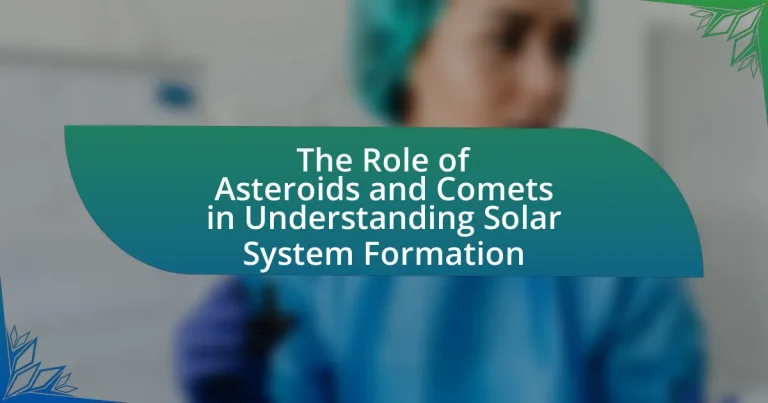Asteroids and comets are essential remnants from the early solar system, providing critical insights into its formation and evolution. These celestial bodies contain primitive materials that have remained largely unchanged for approximately 4.6 billion years, allowing scientists to study the conditions and processes that shaped the solar system. The article explores how the composition of asteroids and comets, including organic compounds and water, informs theories about planetary formation and the origins of life on Earth. It also discusses the methodologies used to study these objects, the implications for planetary defense, and the potential resources they offer for future space exploration.

What is the role of asteroids and comets in understanding solar system formation?
Asteroids and comets serve as crucial remnants from the early solar system, providing insights into its formation. These celestial bodies contain primitive materials that have remained largely unchanged since the solar system’s inception about 4.6 billion years ago. Their composition, which includes ices, organic compounds, and minerals, allows scientists to study the conditions and processes that prevailed during the solar system’s formation. For instance, the analysis of carbonaceous chondrites, a type of asteroid, reveals information about the building blocks of planets and the presence of water and organic molecules, which are essential for life. Additionally, comets, such as those studied by missions like Rosetta, have shown that they may have delivered water and organic materials to Earth, further linking their role to the origins of life. Thus, asteroids and comets are vital for understanding the solar system’s history and the processes that shaped it.
How do asteroids and comets contribute to our knowledge of the early solar system?
Asteroids and comets provide critical insights into the early solar system by serving as remnants from its formation. These celestial bodies contain primitive materials that have remained largely unchanged since the solar system’s inception, allowing scientists to study the conditions and processes that existed over 4.5 billion years ago. For instance, the composition of carbonaceous chondrites, a type of asteroid, reveals information about the organic compounds and water that may have contributed to the development of life on Earth. Additionally, missions like NASA’s OSIRIS-REx and Japan’s Hayabusa2 have returned samples from asteroids, providing direct evidence of their composition and the early solar system’s environment. Such findings enhance our understanding of planetary formation and the distribution of materials in the solar system.
What are the key characteristics of asteroids and comets that make them valuable for study?
Asteroids and comets are valuable for study due to their primitive composition and their roles as remnants from the early solar system. These celestial bodies contain organic compounds and water, which provide insights into the conditions present during the solar system’s formation approximately 4.6 billion years ago. For instance, the presence of carbonaceous materials in certain asteroids suggests that they may have contributed to the delivery of organic molecules to Earth, potentially influencing the origins of life. Additionally, comets, with their icy nuclei, can reveal information about the solar nebula’s temperature and density, further enhancing our understanding of planetary formation processes.
How do the compositions of asteroids and comets differ, and what does this reveal?
Asteroids primarily consist of rock and metal, while comets are composed of ice, dust, and rocky material. This difference in composition reveals the distinct formation environments of these celestial bodies; asteroids formed closer to the Sun where temperatures were higher, preventing the accumulation of volatile compounds, whereas comets originated in the colder outer regions of the solar system, allowing for the preservation of ices. The study of these compositional differences enhances our understanding of the solar system’s formation and the processes that led to the development of various planetary bodies.
Why are asteroids and comets considered remnants of the solar system’s formation?
Asteroids and comets are considered remnants of the solar system’s formation because they are composed of primordial materials that did not coalesce into planets. These celestial bodies formed from the same protoplanetary disk of gas and dust that surrounded the young Sun over 4.5 billion years ago. Their composition, which includes ices, organic compounds, and rocky materials, provides insights into the early solar system’s conditions and processes. Studies of asteroids and comets, such as the analysis of the 2014 Rosetta mission to comet 67P/Churyumov-Gerasimenko, have revealed that these objects contain organic molecules and water, supporting theories about the origins of water and life on Earth.
What evidence supports the idea that asteroids and comets are leftover building blocks?
Asteroids and comets are supported as leftover building blocks of the solar system by their primitive compositions and the presence of organic materials. These celestial bodies contain unchanged remnants from the early solar system, including ices, dust, and organic compounds, which are similar to the materials that formed the planets. For instance, the analysis of carbonaceous chondrites, a type of asteroid, reveals that they contain a mix of minerals and organic molecules that date back to the solar system’s formation over 4.5 billion years ago. Additionally, missions like NASA’s OSIRIS-REx and Japan’s Hayabusa2 have returned samples from asteroids, providing direct evidence of their primordial nature and composition, further confirming their role as building blocks in the formation of planets.
How do the orbits of asteroids and comets provide insights into solar system dynamics?
The orbits of asteroids and comets reveal critical information about solar system dynamics by illustrating the gravitational influences of larger bodies and the historical evolution of the solar system. Asteroids, primarily located in the asteroid belt between Mars and Jupiter, exhibit stable orbits that reflect the gravitational interactions with nearby planets, particularly Jupiter, which helps scientists understand the formation and migration of planetary bodies. Comets, with their highly elliptical orbits, originate from the Kuiper Belt and Oort Cloud, and their trajectories can indicate past gravitational perturbations and interactions with other celestial objects. For instance, the observation of comet orbits can provide insights into the early solar system’s conditions, as many comets are considered to be remnants from its formation. These orbital patterns, analyzed through methods such as numerical simulations and observational data, contribute to a comprehensive understanding of the solar system’s structure, stability, and evolutionary history.

What methods are used to study asteroids and comets?
Asteroids and comets are studied using methods such as telescopic observations, spacecraft missions, and laboratory analysis of samples. Telescopic observations allow astronomers to gather data on the size, shape, and composition of these celestial bodies from Earth or orbiting satellites. Spacecraft missions, like NASA’s OSIRIS-REx and ESA’s Rosetta, provide close-up data by landing on or flying by these objects, enabling detailed analysis of their surface and internal structure. Laboratory analysis of samples returned from these missions offers insights into the chemical and physical properties of asteroids and comets, contributing to our understanding of the early solar system.
How do scientists collect data from asteroids and comets?
Scientists collect data from asteroids and comets primarily through spacecraft missions that utilize various instruments for analysis. For instance, missions like NASA’s OSIRIS-REx and Japan’s Hayabusa2 have successfully gathered samples from asteroids and returned them to Earth for detailed examination. These spacecraft are equipped with spectrometers, cameras, and other sensors that measure surface composition, temperature, and other physical properties. Additionally, flyby missions, such as those conducted by the European Space Agency’s Rosetta, have provided valuable data by observing comets from a distance, capturing images and analyzing gas and dust emissions. These methods enable scientists to gain insights into the primordial materials that contributed to solar system formation, as asteroids and comets are considered remnants from that era.
What technologies are employed in missions to explore these celestial bodies?
Missions to explore celestial bodies such as asteroids and comets employ technologies including spacecraft, remote sensing instruments, and sample return systems. Spacecraft like NASA’s OSIRIS-REx and ESA’s Rosetta are designed to navigate and study these bodies, utilizing advanced propulsion systems for precise trajectory adjustments. Remote sensing instruments, such as spectrometers and cameras, allow for detailed analysis of surface composition and morphology from a distance. Sample return systems, exemplified by OSIRIS-REx’s ability to collect and return material from the asteroid Bennu, enable direct study of the materials that comprise these celestial bodies, providing insights into the early solar system. These technologies collectively enhance our understanding of solar system formation and the role of asteroids and comets within it.
How do remote sensing and sample return missions enhance our understanding?
Remote sensing and sample return missions significantly enhance our understanding of asteroids and comets by providing detailed data on their composition, structure, and history. Remote sensing allows scientists to gather information about the surface features and mineralogy of these celestial bodies from a distance, using instruments that analyze reflected light and other emissions. For instance, NASA’s NEOWISE mission has mapped the thermal properties of asteroids, revealing their sizes and compositions, which are crucial for understanding their role in solar system formation.
Sample return missions, such as Japan’s Hayabusa2 and NASA’s OSIRIS-REx, collect physical samples from these bodies and return them to Earth for in-depth analysis. These samples provide direct evidence of the materials present, allowing researchers to study isotopic ratios and organic compounds that inform theories about the early solar system. For example, Hayabusa2 returned samples from the asteroid Ryugu, which contained organic molecules and hydrated minerals, suggesting that asteroids may have delivered water and organic materials to Earth, a key factor in the development of life.
Together, these missions contribute to a comprehensive understanding of the processes that shaped the solar system, revealing the origins of planetary bodies and the conditions that prevailed during its formation.
What role do space missions play in asteroid and comet research?
Space missions are crucial for asteroid and comet research as they provide direct data and insights that enhance our understanding of these celestial bodies. For instance, missions like NASA’s OSIRIS-REx and Japan’s Hayabusa2 have successfully collected samples from asteroids, revealing information about their composition and the conditions of the early solar system. These missions utilize advanced instruments to analyze surface materials, which helps scientists determine the origins and evolution of asteroids and comets. Additionally, space missions enable close-up observations, allowing researchers to study the physical characteristics and behaviors of these objects, contributing to models of solar system formation.
Which notable missions have significantly advanced our knowledge of these objects?
Notable missions that have significantly advanced our knowledge of asteroids and comets include NASA’s NEAR Shoemaker, which studied the asteroid Eros, and the European Space Agency’s Rosetta mission, which explored comet 67P/Churyumov-Gerasimenko. NEAR Shoemaker provided detailed surface data and insights into the composition of Eros, revealing its history and structure, while Rosetta delivered unprecedented information about the comet’s surface and activity, enhancing our understanding of the early solar system. These missions have contributed critical data that supports theories of solar system formation and the role of small bodies in that process.
What challenges do scientists face when planning missions to asteroids and comets?
Scientists face several challenges when planning missions to asteroids and comets, including the vast distances involved, the unpredictable nature of these celestial bodies, and the need for advanced technology. The vast distances can lead to long travel times, making mission planning complex, as seen in NASA’s Dawn mission, which took nearly eight years to reach its target. The unpredictable nature of asteroids and comets, including their orbits and potential for outgassing, complicates trajectory calculations and mission safety. Additionally, the need for advanced technology, such as autonomous navigation systems and specialized instruments for sample collection and analysis, poses significant engineering challenges. These factors collectively make the planning of such missions a highly intricate and demanding process.

How do asteroids and comets influence theories of solar system evolution?
Asteroids and comets significantly influence theories of solar system evolution by providing insights into the early conditions and processes that shaped planetary formation. These celestial bodies are considered remnants from the solar system’s formation, preserving clues about the primordial materials and conditions present over 4.5 billion years ago. For instance, the composition of carbonaceous chondrites, a type of asteroid, reveals the presence of organic compounds and water, suggesting that these materials may have contributed to the development of life on Earth. Additionally, the study of cometary nuclei, such as those from Comet 67P/Churyumov-Gerasimenko, has shown that they contain complex organic molecules and ices, further supporting the idea that comets delivered essential ingredients for life. The impact of asteroids and comets on terrestrial planets, evidenced by craters and mass extinction events, also provides a framework for understanding the dynamic processes that have influenced planetary evolution.
What theories exist regarding the formation of the solar system involving asteroids and comets?
Theories regarding the formation of the solar system involving asteroids and comets include the nebular hypothesis and the Nice model. The nebular hypothesis posits that the solar system formed from a rotating cloud of gas and dust, where asteroids and comets are remnants of this primordial material. The Nice model suggests that the gravitational interactions between the giant planets caused the migration of these bodies, leading to the current distribution of asteroids and comets. Evidence supporting these theories includes the composition of asteroids, which reflects the early solar system’s materials, and the presence of comets that originate from the Kuiper Belt and Oort Cloud, indicating their role as leftover building blocks from the solar system’s formation.
How do impacts from asteroids and comets affect planetary development?
Impacts from asteroids and comets significantly influence planetary development by contributing to the formation of planetary bodies and altering their geological and atmospheric conditions. These collisions can lead to the accumulation of mass, facilitating the growth of planets through the process of accretion. For instance, during the early solar system, the bombardment of Earth by asteroids and comets delivered essential water and organic materials, which are critical for the development of life. Additionally, impacts can create craters, reshape landscapes, and trigger volcanic activity, further modifying a planet’s surface and atmosphere. Historical evidence, such as the Late Heavy Bombardment period, demonstrates that intense asteroid and comet impacts played a crucial role in shaping the terrestrial planets, including Earth and its moon.
What role do asteroids and comets play in delivering water and organic materials to planets?
Asteroids and comets serve as significant sources of water and organic materials for planets, contributing to their formation and potential habitability. These celestial bodies contain ice and organic compounds, which can be released upon impact or through processes like sublimation. For instance, studies indicate that comets, such as Comet Hale-Bopp, contain a substantial amount of water ice, which can be delivered to planetary bodies during collisions. Additionally, isotopic analyses of meteorites, which are fragments of asteroids, reveal that they possess organic molecules similar to those found in living organisms on Earth. This evidence supports the theory that asteroids and comets played a crucial role in seeding planets with essential ingredients for life, particularly during the early stages of the solar system’s development.
How do asteroids and comets help us understand the potential for life beyond Earth?
Asteroids and comets provide critical insights into the potential for life beyond Earth by serving as time capsules that contain organic compounds and water, essential ingredients for life. These celestial bodies are remnants from the early solar system, preserving the chemical building blocks that may have contributed to the origin of life on Earth. For instance, studies of carbonaceous chondrites, a type of asteroid, reveal the presence of amino acids and other organic molecules, indicating that the basic components of life could be widespread in the universe. Additionally, comets, such as Comet 67P/Churyumov-Gerasimenko, have been found to contain complex organic molecules and water ice, suggesting that they could deliver these vital substances to planets during their formation. This evidence supports the hypothesis that life could potentially arise on other planets with similar conditions, making asteroids and comets key to understanding life’s potential beyond Earth.
What connections exist between the materials found in comets and the origins of life?
Materials found in comets, such as water, organic compounds, and amino acids, are believed to be fundamental to the origins of life on Earth. These materials provide essential building blocks for biological processes. For instance, the presence of amino acids, which are the building blocks of proteins, has been confirmed in cometary samples, indicating that comets could have delivered these vital components to the early Earth. Additionally, the discovery of water ice in comets supports the hypothesis that they contributed to the planet’s water supply, a critical factor for life. Studies, including those from the European Space Agency’s Rosetta mission, have shown that the organic molecules in comets are similar to those found in meteorites, further linking cometary materials to the prebiotic chemistry that may have led to life.
How do asteroids and comets inform our search for extraterrestrial life?
Asteroids and comets provide crucial insights into the search for extraterrestrial life by serving as time capsules that contain organic compounds and water, essential ingredients for life. These celestial bodies are remnants from the early solar system, preserving the chemical building blocks that may have contributed to the emergence of life on Earth. For instance, studies have shown that carbon-rich asteroids and comets can deliver amino acids and other organic molecules, as evidenced by the analysis of materials from the 2014 Rosetta mission to Comet 67P, which revealed complex organic chemistry. Additionally, the presence of water ice in comets suggests that similar bodies could harbor liquid water, a key factor for life, on other planets or moons. Thus, the study of asteroids and comets enhances our understanding of the potential for life beyond Earth by revealing the conditions and materials that may support life elsewhere in the universe.
What practical implications arise from studying asteroids and comets?
Studying asteroids and comets has practical implications for planetary defense, resource utilization, and understanding the origins of life. Planetary defense is crucial as these celestial bodies can pose impact threats to Earth; for instance, the Chelyabinsk meteor in 2013 demonstrated the potential for damage from small asteroids. Resource utilization is significant because asteroids contain valuable materials, such as metals and water, which could support future space missions and even sustain human life in space. Furthermore, analyzing the composition of comets and asteroids provides insights into the early solar system, helping scientists understand the conditions that led to the formation of planets and the emergence of life on Earth.
How can knowledge of asteroids and comets aid in planetary defense strategies?
Knowledge of asteroids and comets is crucial for developing effective planetary defense strategies as it enables the identification, tracking, and characterization of potentially hazardous objects. By understanding their orbits, compositions, and behaviors, scientists can predict potential impacts and devise mitigation techniques. For instance, NASA’s Near-Earth Object Observations program monitors the trajectories of asteroids, allowing for early warning of possible collisions. Historical data, such as the Tunguska event in 1908, highlights the importance of this knowledge, as it demonstrated the destructive potential of an asteroid impact. Thus, comprehensive research on asteroids and comets directly informs and enhances planetary defense initiatives.
What are the potential resources that asteroids could provide for future space exploration?
Asteroids could provide essential resources for future space exploration, including water, metals, and organic compounds. Water, which can be extracted from ice found in some asteroids, is crucial for sustaining human life and can be converted into hydrogen and oxygen for rocket fuel. Metals such as nickel, iron, and cobalt are abundant in many asteroids and can be utilized for constructing spacecraft and habitats. Additionally, organic compounds present in certain asteroids may serve as building blocks for life support systems or fuel. The presence of these resources has been supported by studies, such as those conducted by NASA’s OSIRIS-REx mission, which analyzed the asteroid Bennu and confirmed the presence of water and organic materials.




